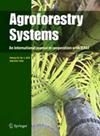Silvopasture is an intentional integration of trees, livestock, and forages within a common land management unit. Despite the significant potential opportunity, silvopasture is not widely adopted by landowners in the mid-Atlantic U.S.A. Limited information exists on silvopasture establishment and its overall management in a real farming context. These case studies were conducted to observe and document various establishment and management approaches for silvopasture among early adopters in Virginia to provide practical information to other producers interested in developing these systems. A questionnaire was developed and four producers in different physiographic regions of Virginia were interviewed. All the producers interviewed manage beef cattle operations. A common motivation behind silvopasture adoption was the opportunity to utilize the shade within the system for livestock health and welfare benefits. In cases where silvopastures were thinned from existing timber stands, the ability to expand grazable land was also a strong motivator. Producers utilized different methods for establishing and managing silvopasture based on their available resources and expertise. Climate change was not a consideration for any producers interviewed in their decision to create or manage silvopasture on their farm. Limited access to information and resources on silvopasture during the early adoption stage was a common experience for all interviewees. Each participant felt that silvopasture has great aesthetic value and can increase biodiversity within the farm. All producers interviewed were interested in expanding the silvopasture land area on their farm but also described various constraints that may hinder their ability to do so.


